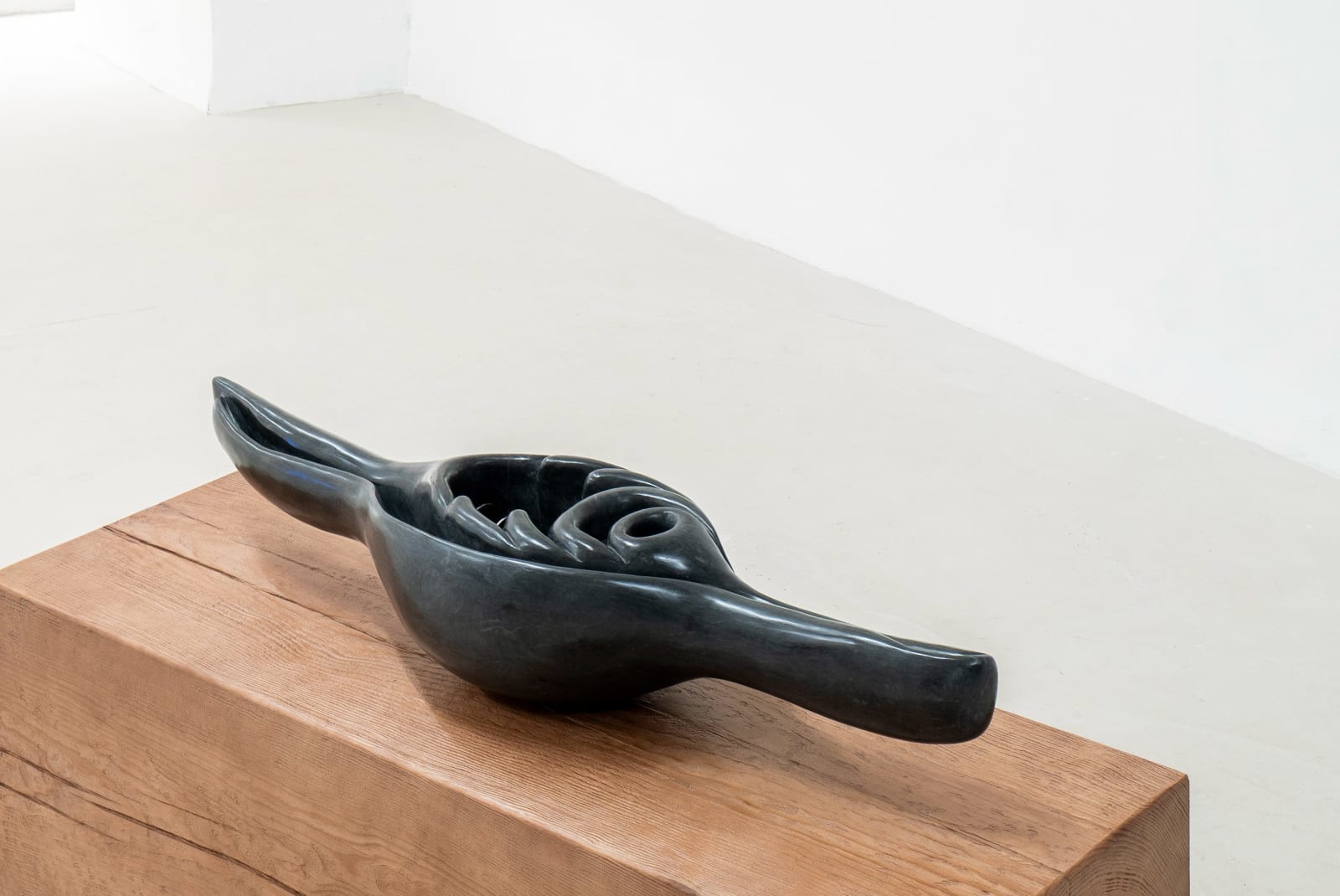Leelee Chan 陳麗同
Shapeshifter (Volva) 变型体(梭螺), 2025
hand-carved China black granite and CNC-milled stainless steel 中国黑花岗岩石,CNC铣削不锈钢
114 x 29 x 21 cm
45 x 11 1/2 x 8 1/2 in
45 x 11 1/2 x 8 1/2 in
Further images
Leelee Chan’s sculptures embody hybrid forms intersecting the architectural, biomorphic, and geological, generating visual paradoxes. Her interplay of abstract forms, intricate details, and unexpected materials also drafts a proposal for...
Leelee Chan’s sculptures embody hybrid forms intersecting the architectural, biomorphic, and geological, generating visual paradoxes. Her interplay of abstract forms, intricate details, and unexpected materials also drafts a proposal for a haptic itinerary that poeticizes critique as much as it underlines its urgency, resisting easy categorization and transcending the limits of a binary interpretation.
In Shapeshifter (Volva), made of hand-carved black granite and CNC-milled stainless steel, Chan continues her investigation of materiality and layered temporality through her astute sensitivity to material objects and her deep reverence for process, interplaying their diverse physical properties and cultural meanings. Specifically alluding to the natural form of Shuttle Volva found in the Indo-Pacific, Chan probes her perpetual fascination with the unsettling metamorphosis of the natural world, particularly the mollusk’s supreme resilience and their ability to shapeshift by reconfiguring and repurposing individual body parts through natural selection for billions of years.
As shell-makers, mollusks are architects that have turned calcium carbonate in the seawater into ceramic spirals whose afterlife has penetrated human civilization since prehistoric times. Biologists suggest that mollusks can read the patterns on their spiral shells as though they were diary entries, a vital element for their memory and orientation before continuing their construction. In this way, the patterns become a collection of memories etched across their shells, almost like a depiction of movement through time without a complete final image.
Instead of a juxtaposition, Chan's sculptures propose rather a form of composition that encompasses multiple stages of the same material history, thus reflecting the entanglement with the more-than-human world and proposing an alternative way of thinking and learning from other forms of intelligence. In doing so, they underline the irreversible modifications of morphology caused by human decisions as they question the fundamental notion of progress and development, ultimately offering an alternative view of the Western constructs of human-centric advancement and growth.
陈丽同的雕塑糅合建筑、生物与地质的形态,制造视觉悖论。抽象形式、精妙细节和出人意料的材料选择相互作用,开启一段触觉的旅程,其批判本质既诗意又迫切,拒绝粗暴的归类和二元的解读。
在《变型体(梭螺)》这件作品中,艺术家融合手工雕刻的黑色花岗岩与数控铣削的不锈钢,延续了她对材料性与层叠时间性的探索。怀着对材料的敏锐感知和对工艺的深切敬意,她将各种物质特性和文化涵义巧妙地交织在一起。一直以来,陈丽同对大自然的形变感到着迷,尤其是软体动物在千万年物竞天择的过程中,重塑身体结构的惊人韧性和灵活性。这件作品的灵感便来源于印度洋-太平洋海域中的梭螺(Shuttle Volva)。
软体动物如建筑师般造壳,它们将海水中的碳酸钙转化为陶瓷般的螺旋体。这些壳体的“遗骸”自史前时代起便渗透进人类文明。生物学家认为,软体动物能够“阅读”自己壳体上的纹路,如同翻阅日记。这些纹理是它们记忆与导航的工具,帮助它们不断筑造。因此,壳体上的纹理是记忆的线索,镌刻着主人的行动轨迹。
陈丽同的雕塑并非简单地将异质元素并置,而是通过一种复合的结构,使同一材料的多个历史阶段得以共存,反映人类与“超人类”世界之间的深度纠缠,促使人们重新理解和学习人类以外的生命形态。她的作品质疑“进步”与“发展”的概念,揭示人类行为所带来的不可逆的改变,对西方人类中心主义的发展观提出替代性的视角。
In Shapeshifter (Volva), made of hand-carved black granite and CNC-milled stainless steel, Chan continues her investigation of materiality and layered temporality through her astute sensitivity to material objects and her deep reverence for process, interplaying their diverse physical properties and cultural meanings. Specifically alluding to the natural form of Shuttle Volva found in the Indo-Pacific, Chan probes her perpetual fascination with the unsettling metamorphosis of the natural world, particularly the mollusk’s supreme resilience and their ability to shapeshift by reconfiguring and repurposing individual body parts through natural selection for billions of years.
As shell-makers, mollusks are architects that have turned calcium carbonate in the seawater into ceramic spirals whose afterlife has penetrated human civilization since prehistoric times. Biologists suggest that mollusks can read the patterns on their spiral shells as though they were diary entries, a vital element for their memory and orientation before continuing their construction. In this way, the patterns become a collection of memories etched across their shells, almost like a depiction of movement through time without a complete final image.
Instead of a juxtaposition, Chan's sculptures propose rather a form of composition that encompasses multiple stages of the same material history, thus reflecting the entanglement with the more-than-human world and proposing an alternative way of thinking and learning from other forms of intelligence. In doing so, they underline the irreversible modifications of morphology caused by human decisions as they question the fundamental notion of progress and development, ultimately offering an alternative view of the Western constructs of human-centric advancement and growth.
陈丽同的雕塑糅合建筑、生物与地质的形态,制造视觉悖论。抽象形式、精妙细节和出人意料的材料选择相互作用,开启一段触觉的旅程,其批判本质既诗意又迫切,拒绝粗暴的归类和二元的解读。
在《变型体(梭螺)》这件作品中,艺术家融合手工雕刻的黑色花岗岩与数控铣削的不锈钢,延续了她对材料性与层叠时间性的探索。怀着对材料的敏锐感知和对工艺的深切敬意,她将各种物质特性和文化涵义巧妙地交织在一起。一直以来,陈丽同对大自然的形变感到着迷,尤其是软体动物在千万年物竞天择的过程中,重塑身体结构的惊人韧性和灵活性。这件作品的灵感便来源于印度洋-太平洋海域中的梭螺(Shuttle Volva)。
软体动物如建筑师般造壳,它们将海水中的碳酸钙转化为陶瓷般的螺旋体。这些壳体的“遗骸”自史前时代起便渗透进人类文明。生物学家认为,软体动物能够“阅读”自己壳体上的纹路,如同翻阅日记。这些纹理是它们记忆与导航的工具,帮助它们不断筑造。因此,壳体上的纹理是记忆的线索,镌刻着主人的行动轨迹。
陈丽同的雕塑并非简单地将异质元素并置,而是通过一种复合的结构,使同一材料的多个历史阶段得以共存,反映人类与“超人类”世界之间的深度纠缠,促使人们重新理解和学习人类以外的生命形态。她的作品质疑“进步”与“发展”的概念,揭示人类行为所带来的不可逆的改变,对西方人类中心主义的发展观提出替代性的视角。















